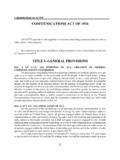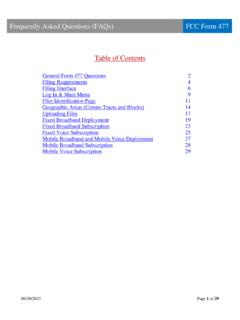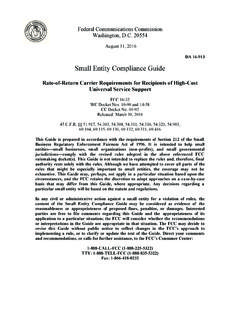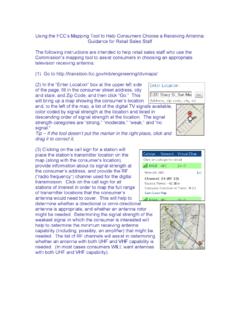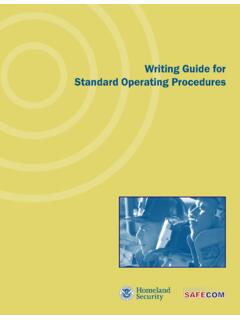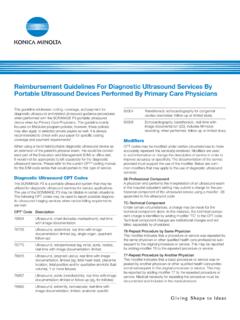Transcription of 21 Types Of News - Federal Communications Commission
1 21 types of news In the first several chapters, we saw media systems in flux. Fewer newspaper journalists but more websites, more hours of local TV news but fewer reporters, more news /talk radio but less local news radio, national cable news thriving, local cable news stalled. But what matters most is not the health of a particular sector but how these changes net out, and how the pieces fit together. Here we will consider the health of the news media based on the region of coverage, whether neigh- borhood, city, state, country, or world. Hyperlocal The term hyperlocal commonly refers to news coverage on a neighborhood or even block-by-block level.
2 The tradi- tional media models, even in their fattest, happiest days could not field enough reporters to cover every neighborhood on a granular level. As in all areas, there are elements of progress and retreat. On one hand, metropolitan newspapers have cut back on regional editions, which in all likelihood means less coverage of neighborhoods in those regions. But the Internet has revolutionized the provision of hyperlocal information. The first wave of technology . LISTSERV and other email groups made it far easier for citizens to inform one another of what was happening with the neighborhood crime watch or the new grocery store or the death of Citizens can now snap a beloved senior who lived on the block for 40 years.
3 More recently, social media tools have enabled citizens to self-organize, and connect in ever more picture of potholes and dynamic ways. Citizens can now snap pictures of potholes and send them to send to city hall, or share city hall, or share with each other via Facebook, Twitter or email. New tools them with each other. allow citizens to mine citywide information in ways that create hyperlocal stories: a database on restaurant health violations becomes a story about a diner down the block. Hyperlocal blogs presenting a mix of reporting, com- mentary, and aggregation are popping up throughout the country. They will not, for the most part, become success- ful businesses but they do not have to.
4 Volunteers can operate hyperlocal media just as volunteers organize clean-up days for the block. These tools not only help the purely volunteer-based media but have given opportunities to commercial Inter- net ventures too. Many local TV stations have added hyperlocal areas to their websites. AOL's Patch, , and Everyblock each rely on community members to contribute content for free or for a small fee. Two unknowns: so far, hyperlocal print weeklies have fared reasonably well in the new media economy (See Chapter 1, Newspapers.) But they will likely feel increasing pressure as online classifieds services, like Craigslist, and sites like and Patch, extend their reach into smaller communities and as locally originated sites are launched and/or expand.
5 Finally, recent legislation allowing for the growth of low-power FM may bring a wave of hyperlocal radio sta- tions, especially in urban areas. These stations have only enough power to broadcast on a neighborhood basis, but it is unclear how they will be utilized. (See Chapter 11, Low Power FM.). City and State Local metropolitan and state-level coverage represent the areas of greatest concern especially when it comes to how often and how thoroughly journalists report on powerful institutions such as city hall, the school board, the state- house, and the local hospital. Almost every sector of media that covered these beats in the past has been shaken and transformed.
6 Throughout Part One we looked at the positive and negative developments. To summarize: 230. > Newspapers, which had been the main source for this kind of reporting, have cut back staff. There are strong signs that these cutbacks have weakened coverage of schools, health care issues, city government, state leg- islatures, religion, and other important topics. Although many newspapers have become quite innovative online in the past couple of years, it generally has resulted in an increase in the ways news is presented, but not in the number of reporters gathering news . Even when beats have not been eliminated entirely, beat reporters have become responsible for covering more territory and feeding the beast by tweeting and writ- ing blog posts in addition to their regular stories.
7 These days, many newspapers reporters spend less time interviewing sources and more time producing copy. They have less time for enterprise journalism of the sort that anticipates problems and uncovers information that those in power want to conceal. > Local radio has not stepped in to fill the void. In fact, the number of cities that had all- news radio stations dropped from 50 in the 1980s to 30 in 2010. Robert Papper, who surveys radio station news directors for the Radio Television Digital news Association, says: I can say this without a doubt there are far fewer stations doing news than 10 years ago, there are far fewer people hired by commercial radio to work in the newsrooms, and the median number of people employed in a commercial radio newsroom has been one' for quite a few years.
8 1. Although there are notable exceptions around the country, it's not realistic to expect that radio will counteract the loss of newspaper jobs. > Local TV has, in some ways, expanded its role in the local news ecosystem. The number of hours of news aired has grown, and increasing numbers of stations are making full use of social media to enliven and enhance the quality of broadcasts. For instance, many stations now incorporate user videos, photos, and commentary to enhance coverage of natural disasters. Some stations continue to produce high-quality in- vestigative journalism, as well. But on balance, stations have not increased their reportorial capacity, and in many cases they The tired idea that born- have cut it back.
9 As a result, several long-standing maladies of on-the-web news sites will local news have persisted, or even worsened, including: mini- mal coverage of local government, insufficient in-depth report- replace traditional media is ing, and a strong emphasis on crime coverage. Although they wrong-headed, and it's past are not in the majority, a disturbing number of stations have time that academic research allowed advertisers to dictate news content or in other ways blurred the lines between journalism and advertorial. In short, and news reports reflect many stations are doing excellent work and many more have that, said Michele McLellan the capacity to do even better but, as yet, most stations have not been fielding enough reporters to fill the vacuum left by lo- after studying news websites.
10 Cal newspapers. > Cable TV, like radio, is thriving nationally (financially and in terms of audience), offering more national and business news programming than ever. But locally focused models have stalled, with local cable news efforts currently reaching only about 20 to 30 percent of the population. There are some hopeful signs for instance, Time Warner and NBC/Comcast have announced plans to expand their local news efforts but most other cable operators seem more inclined to freeze or cut back their local operations, as they are costly to maintain. > Satellite TV has technological limitations and financial disincentives that make it an unlikely platform for increased local public affairs programming.
